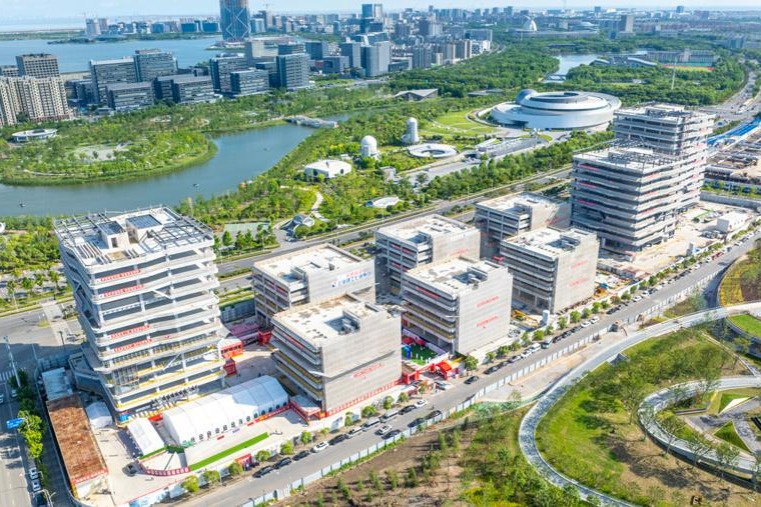Rite of passage
Advancing construction of the economic corridor between China and Europe calls for greater strategic mutual trust among the participating countries


Advancing construction of the economic corridor between China and Europe calls for greater strategic mutual trust among the participating countries
Among the Belt and Road Initiative's six economic corridors, the New Eurasian Land Bridge Economic Corridor stands out as the only direct link between China and the developed European countries. It has created a new passage of trade and logistics between Europe and Asia, and has strengthened the resilience of the global supply chains.
In recent years, within the framework of the BRI and facilitated by the growing political mutual trust between China and Eurasian Economic Union countries, the long overdue China-Kyrgyzstan-Uzbekistan Railway has been put under construction. Meanwhile, China's trade volumes with countries along the corridor keep growing. For instance, China and Russia have achieved the goal of bringing bilateral trade volume to $200 billion by 2024 ahead of schedule. Between 2014 and 2022, trade in goods between China and 17 Central and Eastern European countries increased by 120.5 percentage points, 3.2 times the growth rate of trade between China and the European Union in the same period. Up to now, the China-Europe freight trains have reached 217 cities in 25 European countries. Landmark projects such as the Hungarian-Serbian railway and China-Kazakhstan and China-Belarus production capacity cooperation are garnering international recognition.
At the same time, problems and challenges exist alongside the construction of the corridor. First, headwinds come from the policy communication and people-to-people exchanges. The areas along the corridor have always been the center of the geopolitical power play among major powers. The lingering Russian-Ukraine conflict has had a direct impact on the corridor. So has the Baltic states' successive withdrawal from the "17+1" platform, or the cooperation mechanism between China and the Central and Eastern European countries. Second, there is the problem of the unevenly distributed infrastructure connectivity along the corridor. Third, the free flow of trade is increasingly blocked by political factors, with the changes in the EU's China policy being the chief reason. Imbalanced and single economic structures still bother the countries along the corridor. Last, construction of the corridor has limited financing channels and relies heavily on the bank credit provided by the Chinese side. Risks of default loom from low- and middle-income countries along the corridor.
Because of these considerations, the high-quality construction of the economic corridor requires the deepening of strategic mutual trust among the participating countries.
First, policy communication and cooperation needs to be more transparent and standardized, while being attuned to the international rules and the EU's laws and regulations. Exchanges and cooperation between the BRI and the EU's Global Gateway strategy should be further explored, therefore attracting the developed European countries to jointly carry out trilateral cooperation in Central and Eastern Europe countries, if not establishing an official mechanism of cooperation covering all countries along the corridor.
Second, it is necessary to improve the connectivity capacity of facilities among the Eurasian countries. Efforts need to be made to jointly promote the upgrading and transformation of core technologies in key sectors, enhance the distribution capacity of key hubs, and improve the operation quality and safety of China-Europe freight trains. Its information platforms and smart ports should open up and keep up, along with a set of internationally accepted trade rules and standards.
Third, it is crucial to expand the scale of trade and investment, and carry out targeted cooperation in the industrial and technological sectors. China should actively respond to EU's demands for China-EU economic and trade cooperation, promote the balanced development of bilateral trade, and implement the plan to expand its imports from Central and Eastern European countries, especially the imports of advantageous and special agricultural products. On top of that, projects allowing young scientists from countries along the corridor to work in China should be facilitated, so that a joint feasibility study on the free trade agreement between China and the Eurasian Economic Union can be reached.
Finally, it is imperative to improve the financial cooperation mechanism and expand the coverage of cross-border renminbi settlement. China should seek to strengthen cooperation with third countries and multilateral financial institutions as well, attract private capital, and build a long-term, stable, and diversified financing system for the corridor. China's financial institutions are well motivated to open more outlets in countries along the corridor, and this can help broaden the channels for renminbi investment and financing. Cooperation in digital currency and green finance should be on the future agenda. Accordingly, there is the need to establish a real-time monitoring and early-warning system for debt risks of the participating countries. The end goal is to seek long-term and targeted solutions to debt problems and foster sustainable development for all.
The author is a research assistant with the US and Europe Research Department at the China Center for International Economic Exchanges. The author contributed this article to China Watch, a think tank powered by China Daily. The views do not necessarily reflect those of China Daily.
Contact the editor at editor@chinawatch.cn


































